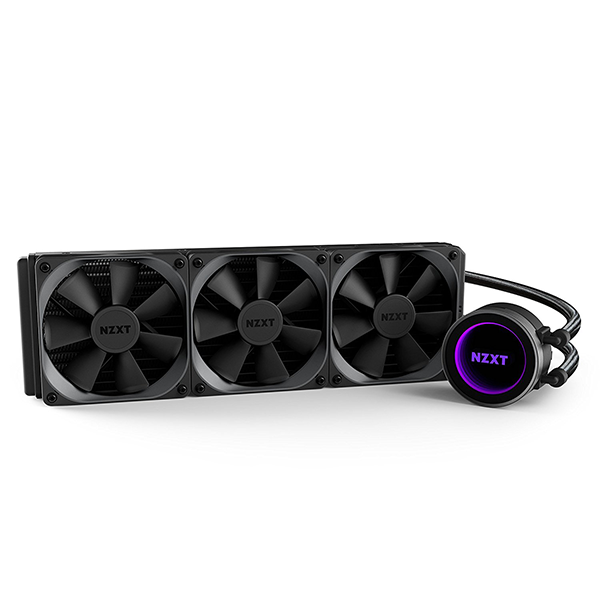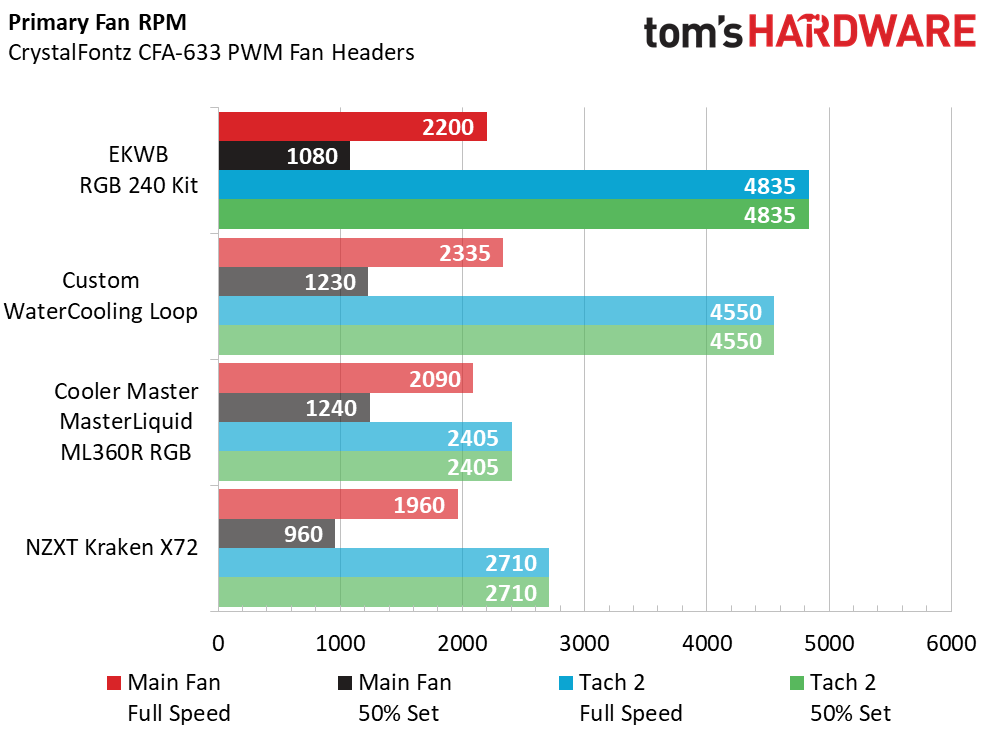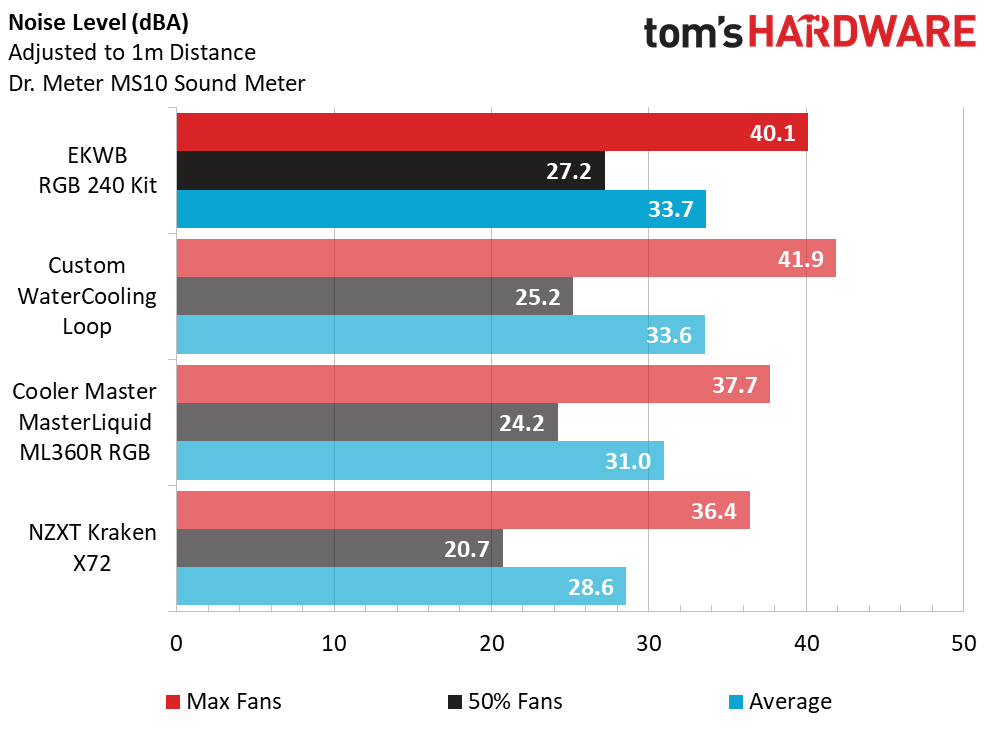EKWB EK-Kit RGB 240 Cooler Review: Top-Shelf Looks and Performance
Why you can trust Tom's Hardware
Testing Results and Conclusion
Comparison Coolers
We will be comparing the EK-Kit RGB 240 to two large 360 AIO coolers in the Cooler Master MasterLiquid ML360R and NZXT Kraken X72. We're also offering some comparison against our bespoke watercooling test system:
| Pump | Swiftech MCP50X |
| CPU Block | EK-Supremacy EVO Nickel (Intel) |
| Reservoir | Swiftech MCP35X/MCP50X rev.2B Acrylic |
| Fittings | Bitspower Matte Black ½”ID x ¾” OD Compression (x6) |
| Radiator | XSPC EX360 |
| Fans | Scythe Ultra Kaze 3000 RPM 120mm (x3) |
| Tubing | ½”ID x ¾”OD clear |
| Coolant | Distilled Water, no additives, coolants or dyes |
There were very close test results between the EK-Kit RGB 240 and the custom watercooling loop. Meanwhile, the MasterLiquid ML360R went toe-to-toe with the high-end watercooling systems, with the Kraken X72 following close behind.
The EK Vardar fans clocked in at their full 2,200 RPM potential on our test system while the D5 pump itself exceeds 4,800 RPM while remaining nearly whisper-quiet at full speed.
Fan speeds almost always provide an indication to relative noise levels, and, again, the higher speeds of the EK Vardar fans kicked up quite a bit of air turbulence, although not quite to the level of the Scythe Ultra Kaze fans on our custom watercooling system. The MasterLiquid ML360R and Kraken X72 managed to fare a bit better than both cooling systems, however, with lower decibel readings.
With the entire quartet of cooling systems doing very well in thermal tests, but the ‘bigger’ watercooling loops churning out high noise values, the Acoustic Efficiency chart favors the AIO coolers. With the numbers we’ve seen so far, all four of these solutions would benefit very much from well-tuned fan curves.
The most sobering chart of all includes unit price as a comparison value. The AIO coolers by Cooler Master and NZXT undercut the open-loop solutions by almost half. With the EK-Kit RGB 240 topping the chart with a $460 price tag and the pair of 360 AIOs doing well in comparison, there isn’t really a value statement to be had in favor of today's review focus.
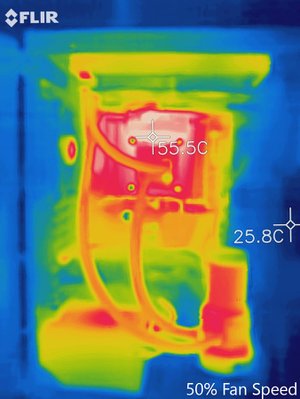
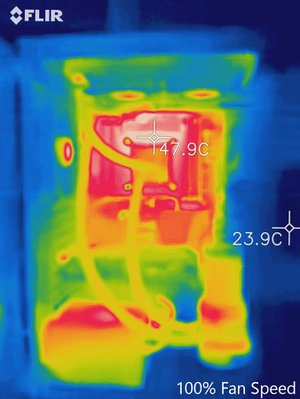
Thermal imaging from the FLIR ONE Pro camera shows some minor differences between full- and half-speed fan settings, with the most notable being the marginally higher shading of the EK-CoolStream PE 240 radiator at half-speed. Here, there's additional heat soak in the reservoir, pump, tubing and the CPU block itself from slightly elevated coolant temperatures at 50 percent fan RPM. Comparison of the chassis and surrounding hardware otherwise show a very similar thermal footprint.
Get Tom's Hardware's best news and in-depth reviews, straight to your inbox.
Manufacturing quality is difficult to express with images destined to live their days on web pages designed for responsive browsing, but each and every component in the EK-Kit 240 RGB package has the look and feel of precision engineering and excellent quality control. The milling of the pump top and reservoir are top-notch, while the mirror-like finish on the EK-Supremacy EVO CPU block is exceptionally beautiful. The EK-XRES D5 pump and reservoir combination unit has an included rubber damping ring, and the pump mount itself allows for nearly every installation position. The EK-CoolStream PE 240 radiator has a noticeable heft to it, indicating the large mass of copper and brass that went into creating a quality heat exchanger. Each fitting is adorned with the EK logo and further wrapped with raised thumb grip ridging, and every single machine screw in the package can be torqued down via hex-key wrenches only (none of that ‘pedestrian’ Phillips screwdriver nonsense here).
Even with the big, 360 AIOs performing remarkably close in load testing, open loops are like exotic or luxury automobiles, going just a little bit further than the norm with presentation levels reaching the oh-so-good grandeur that makes for delectable technology eye candy. High-end watercooling builds are like the Ferraris and Bentleys of the PC world; they look fabulous, and those who are willing to pay top dollar will certainly do so. The EKWB EK-Kit 240 RGB just makes such builds easy to look at and also perform favorably, for a price.
MORE: Best CPU Cooling
MORE: How To Choose A CPU Cooler
MORE: All Cooling Content

Garrett Carver is a contributor for Tom’s Hardware, primarily covering thermal compound comparisons and CPU cooling reviews; both air and liquid, including multiple variations of each.
-
jimmysmitty That price kills the value. The Cooler Master performs better and is quieter for 1/3rd the price. However it is of course a triple rad so wont fit in as many as the EXWB but still that price is harsh.Reply -
rubix_1011 Reply21395957 said:That price kills the value. The Cooler Master performs better and is quieter for 1/3rd the price. However it is of course a triple rad so wont fit in as many as the EXWB but still that price is harsh.
Price is pretty steep for most people, but those who are in the market for a kit like this aren't likely wanting an AIO anyway. I think there is definitely a line in the sand when it comes to liquid cooling - AIO and watercooling loops draw either one specific crowd or the other.
Plus side is, you can easily expand to add another radiator and a graphics card at a 'moderate' additional investment.
And yes, anything that is a 360 radiator is difficult to fit in most cases. Wait until you see an upcoming review on another cooling kit...radiator won't even fit in the Corsair Graphite 760T...it gets a roof mount. -
jimmysmitty The 760T is not a tiny case so that's pretty crazy but more modern cases that remove the 5.25" basy are more for that. I have been considering putting a triple rad in my 570X using the front RGB fans for push and the others as a pull setup but am waiting to see what that new Corsair kit is going to be.Reply
There will be people who want this but for me its hard to justify spending 3x the cost for less performance. I guess if you want a more custom lopp, say you have a motherboard with built in cooling channels and GPU sure its probably better to go with this especially for asthetics and space. -
rubix_1011 The 5.25 bay *could* be removed on the Corsair 760T, but since I use it for all cooling tests, modding it to suit just one review and then having to re-rivet the drive cage back together wasn't in the cards. But yes, it could have been made to fit and if it were my personal case and kit, I would have done so.Reply
I think the thing to look at when it comes to AIO cooling is that for so long, they really struggled to cool well at all. Better pumps have come along which are making a difference in how well they work, but you're still paying lesser quality components - plastic and aluminum vs. brass, copper and high-grade acrylics and plexi's.
I guess I just see it is a different step - sure, performance is similar on some AIOs vs. custom watercooling, but the AIOs just don't carry the 'oomph' factor when it comes to visual appeal (in my mind, personally). -
AnimeMania So is that price considered expensive compared to buying all the parts separately or just compared to buying an AIO unit.Reply -
jimmysmitty Reply21396075 said:So is that price considered expensive compared to buying all the parts separately or just compared to buying an AIO unit.
Just to AiO. Buying individual parts that are similar would be similar or close in price.
Custom loops are better though. I see why people would want this over an AiO. I guess I just have not kept up on performance of AiOs. I was used to AiOs being close to top end air with custom loops blowing them away. -
jpe1701 So I went back to the evga clc 280 review to make a comparison because that's what I use. Why are the temps so different? All of the 280mm rads in that review had lower temps than these, and the clc280 was significantly lower(37 over ambient at 100% fan).Reply -
mac_angel I've always been curious about what the actual volume of coolant is used in these kits and how that may make a difference. This used a 240mm RAD, but also has a reservoir. More coolant does also mean more cooling capabilities.Reply -
BulkZerker @mac_angelReply
More cooling fluid does not mean better cooling performance. Surface area on the cooler block and radiator is what matters. Having a huge reservoir just means you have more fluid to "heat soak" before you can get a honest idle / load temperature. That's why early on a lot of less reputable sites were getting absolutely bonkers temp readings for AIO kits. They booted into windows, grabbed an idle temp after 30 second day of being fully logged in, the ran a single benchmark loop that lasts all of 5 minutes at most. Even the most anemic AIO coolers available didn't have time to fully heat up the entire cooler. -
mac_angel Reply21396234 said:@mac_angel
More cooling fluid does not mean better cooling performance. Surface area on the cooler block and radiator is what matters. Having a huge reservoir just means you have more fluid to "heat soak" before you can get a honest idle / load temperature. That's why early on a lot of less reputable sites were getting absolutely bonkers temp readings for AIO kits. They booted into windows, grabbed an idle temp after 30 second day of being fully logged in, the ran a single benchmark loop that lasts all of 5 minutes at most. Even the most anemic AIO coolers available didn't have time to fully heat up the entire cooler.
I get that it would take more to heat up, and surface area of the CPU block to tranfer heat, as well as a well deigned radiator can dissipate the heat better, but i was curious if a reservoir and/or extra volume would make much of a difference as well. The coolant temperature coming off of the CPU block would be higher than ambient, even in the case (assuming you have adequate air flow). All that tubing, larger tubing, metal fitings, and reservoir all add up to more surface area. I was just curious as to how much.
More day dreaming since I don't have the money, but I thought of a build using longer than average tubing. Other exotic cooling ideas, too. But wondered if more volume and tubing makes any difference.


